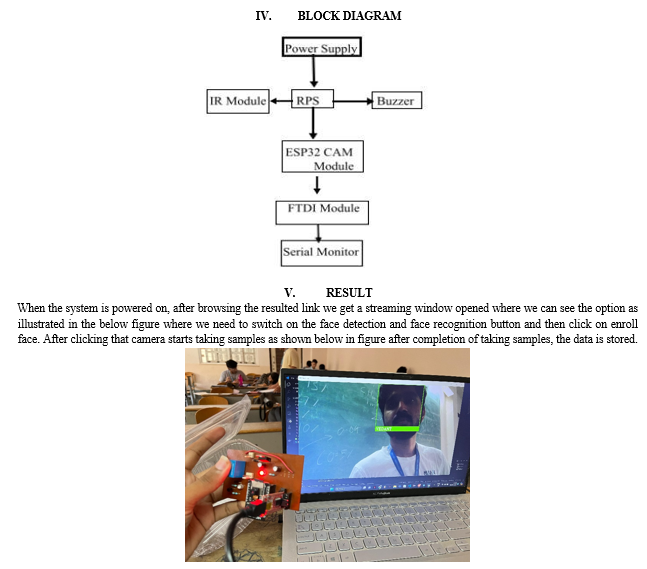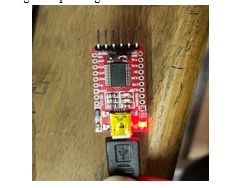Ijraset Journal For Research in Applied Science and Engineering Technology
- Home / Ijraset
- On This Page
- Abstract
- Introduction
- Conclusion
- References
- Copyright
Face Recognition Based Attendance System using ESP 32CAM
Authors: Dev Bhanushali, Prathamesh Godbole, Vedant Pednekar, Prof. Manjusha Kulkarni
DOI Link: https://doi.org/10.22214/ijraset.2024.61548
Certificate: View Certificate
Abstract
In the modern industrial system, attendance logging is essential to raising system quality. Thus, it is necessary to have a robust computerized Face detection attendance recording system that uses an ESP32 camera. Each and every organization has strict attendance policies. It takes time and effort to manually maintain an attendance register. For example, RFID and biometric technology are two ways of solving the same issue. This research outlines a creative and efficient method for determining presence and verifying attendance. The ESP32 microcontroller family features integrated Wi-Fi and dual-mode Bluetooth. This facial detection-based technology does not require a person to be in close proximity to the fingerprint reader module, in contrast to biometric attendance systems. The biometric device becomes contaminated when the same employee or student records their attendance using the same biometric system. Furthermore, the likelihood of a proxy in RFID is considerable. This forecast will track student or employee attendance using facial recognition technology.
Introduction
I. INTRODUCTION
Other attendance methods, such RFID and biometric systems, are being displaced by face recognition-based systems. This endeavour contributes to the decrease in both the infectious problem and the number of proxies. The ESP32 CAM module is utilized in this project in conjunction with an IR module for object detection, an FTDI module for board control and data transmission from the cam module to the system, and a regulated power supply to supply the ESP32 module with the appropriate amount of power. This method, which automates the organization's attendance, aims to lessen the drawbacks of the current manual approach. Through the use of biometric attendance systems, the virus spreads swiftly. In many schools and colleges, the most widely used attendance system is based on biometric technology [3]. The system will get contaminated and the virus will have an opportunity to spread swiftly if an infected employee unintentionally contacts the biometric system while recording attendance. The goal of developing an attendance management system is to mechanize the labour-intensive manual attendance taking procedure. An automated attendance management system does much of the day-to-day tracking and analysis of attendance with minimal help from humans. This research proposes an approach that uses facial recognition. Applications for access control, video surveillance, and authentication commonly use facial recognition. This method tracks a person's face continually using an ESP32 camera sensor.
This method will cut down on paperwork by doing away with the requirement for human attendance recording. Additionally, the new method will reduce the total time required to record attendance. The new technology will use facial recognition to collect individual attendance, ensuring the accuracy of the attendance data.
Deshpande, N.T., and Ravishankar [4] provide an efficient method for face detection and recognition using Viola-Jones, fusion of PCA and ANN methodologies. It is demonstrated that the recommended method obtains a greater level of recognition accuracy when its performance is compared with other facial recognition systems currently in use. The Viola-Jones technique is necessary for face detection and recognition in many different applications. The suggested method can be compared to other methods currently in use because most applications aim for a high rate of identification accuracy.
The present situation of the educational system and other locations where attendance is manually recorded have been discussed by the author [5]. We still take attendance manually, even in this day and age when there are so many technological options available. They keep a personal log of attendance and update it on several portals. We can take advantage of this method by using RFID tags and the Internet of Things (IOT) to automatically take attendance. We could use the cloud as storage with the Internet of Things to increase speed. According to author [6], when a person is too lazy to attend a certain class, someone else helps them sign for attendance even if they weren't there. However, the system ignores this because there is insufficient enforcement of this policy. The institution could have to expend a lot of time and human resources if enforcement is implemented, which is not practical.
The recorded attendance from the previous system is therefore unreliable for research purposes. The daily attendance is entered into the database by the administrator. The data is taken from the database whenever a particular student's photo is taken. The database has the ability to update student attendance, and it can provide parents attendance information through text message on their mobile device [7].
II. APPROCH
The purpose of the proposed system is to develop a face recognition-based attendance system. In addition to automatically recording attendance in a face recognition attendance system, facial recognition technology is used to identify and authenticate individuals based on their facial traits [8]. The program can be used to identify workers, students, and employees, among other groups of people. The proposed attendance system logs data, including names, dates, and times, and identifies individuals. The effectiveness of the suggested attendance method depends only on the quality of the student images taken, the camera's resolution, and the number of students enrolled [9].
The ESP32 camera-based system was made as user-friendly as possible without sacrificing any analytical features. One such feature is the temporal aspect of the camera's detection of the object in front of it, or more specifically, how quickly and how far it can be detected. Resolution parameters like CIF and QVGA, which are utilized for photo and face identification, suggest speed[10]. A student's picture is taken, and the information is taken from the database to ascertain attendance.
- ESP32 CAM: The ESP32 is a family of low-cost, low-power system-on-a-chip microcontrollers has dual-mode Bluetooth and built-in Wi-Fi. Tensilica Xtensa LX6 dual-core or single-core microprocessors and Tensilica Xtensa LX7 dual-core or single-core RISC-V microprocessors power the ESP32 series, which also features integrated filters, power-management modules, RF baluns, power amplifiers, low-noise receive amplifiers, and antenna switches. The ESP32 was designed and developed by Espressif Systems, a Chinese company based in Shanghai. TSMC uses their 40 nm technology to manufacture the device. It is a replacement microcontroller for the ESP8266. Numerous iterations of the ESP32 have been unveiled and introduced since the first one was released. They belong to the family of microcontrollers called ESP32. These chips are essentially code-compatible and use the same SDK, despite having different CPUs and capacities. In addition, changes were made to the original ESP32. Numerous Internet of Things applications are appropriate with the ESP32CAM. Retail home appliances, wireless positioning system signals, wireless monitoring, industrial wireless controls, QR wireless identification, and other Internet of Things applications can all make use of it. For Internet of Things applications, it's a great option. This method [11] uses an ESP32 camera sensor to monitor a subject's face continually. The ESP32-Cam's SD card stores the faces of the authorized users. The esp32 cam compares a person's face to a database of approved faces in order to identify them when they stand in front of the door. The "AI-Thinker" algorithm is utilised in detecting and recognising a person's face
- RPS: An integrated circuit (L7805 in our project) known as a regulated power supply (RPS) changes alternating current into continuous direct current. With the aid of a rectifier, it converts the source of alternating electricity into direct current. Its function is to supply a circuit or device that needs to operate under specific power supply limits with a constant voltage (or, less frequently, a constant current). The output of the regulated power supply is nearly always direct current, however it can also be unidirectional or alternating. The stabilization technique used can be restricted to guaranteeing that the output remains within predetermined bounds under various load scenarios, or it can also include adjustments for fluctuations in its own supply source.
- FTDI Module: The FTDI is a high-quality, highperformance bi-directional USB to 5V TTL converter with a 9-pin connector. It consists of two products: a USB to RS232 Adapter (USB-232- 2) that uses the FTDI chipset and an RS232 to 5V TTL Converter. (TTL-232-5P). Any typical full-duplex USB port can be converted to a 5V TTL signal in either way. The item is powered by the USB connection and does not require any other power. It also has auto-turnaround data direction, which eliminates the requirement for flow management. When data is present, the autosensing data turnaround automatically activates the TTL driver, making the device plug-and-play. On the USB side, there is a Type A female connector, and on the TTL side, there is either a DB9 male connector or a 5-way terminal block. The package has a separate terminal block.
III. METHDOLOGY
To implement the system, first connect the devices as shown in the figure below using a block diagram as illustrated in the above figure, and then turn on the power supply, where a 12volt adapter is used to convert the AC power into DC power, and this power is supplied to the RPS, which supplies an equal amount of power to the devices, which in this case is an ESP32 CAM module.
In the Arduino IDE, a program is created to control the ESP32 CAM module. The code written in the Arduino is dumped on the board using the FTDI module.
For two-way communication between the ESP32 and the browser, this project uses the Arduino AI Thinker library. The ESP32 is used for all face detection, capture, and recognition, and there are buttons that operate the ESP32. They are STREAM, which just streams the camera's frames, DETECT, which detects faces in the stream, CAPTURE, which captures the current face, and RECOGNISE, which matches a face from the camera to a previously captured face. When this ESP32 CAM is powered on, it begins streaming, and we can watch the stream using the network device finder app, which provides the IP address of the ESP32 CAM module. After copying the IP address and browsing it in the browser, the surveillance window is opened. On the monitor, we will see a settings option where we can start or stop the streaming, record the video, and adjust the resolution to our liking, as well as face recognition and face detection buttons. Below these two options, we will see another button labelled enroll. By selecting the enroll face button, the system begins taking pictures of the person to store in the database; here, it takes 5 samples of each person, registering the person.
When a person stands in front of the system, the IR module detects an object, indicating a person, which causes the esp32 CAM to begin scanning, recognising the person in order to mark the attendance. If the person is registered and their data is present in the database, their attendance is marked; else the person is not recognized, indicating an unauthorised person.



Conclusion
Any firm can manage their attendance system more successfully with the help of this project. The goal of the face recognition attendance management system is to solve issues with the existing manual systems. The system will save time, reduce the amount of work that the administration must do, replace stationery with electronic equipment, and reduce the amount of manpower needed for the purpose. This methodology makes it easy to address the problem of proxies and marking students present even when they are not. This approach also lessens the chance of germs spreading because it doesn\'t involve touching.
References
[1] Ravi Shankar Saxena et al., “Automatic Attendance Management System Using Face Recognition,” 2022. [Online]. Available: www.ijrpr.com [2] R. S. Akshaya, K. Devi, J. Juhidha, R. Priyanka, R. Kanimozhi, and A. Nagar, “IOT based Face Recognition Smart Attendance System using ESP 32 cam,” Int J Innov Res Sci Eng Technol, vol. 10, no. 5, 2021, doi: 10.15680/IJIRSET.2021.1005214. [3] J. Khyat, K. N. Divya Bhargavi, M. R. Rao, and P. V. V. N. D. P. Sunil, “Face Detection Based Attendance System Using ESP32”. [4] N. T. Deshpande and S. Ravishankar, “Face Detection and Recognition using Viola-Jones algorithm and Fusion of PCA and ANN,” 2017. [Online]. Available: http://www.ripublication.com [5] V. Gupta, A. Kumar, A. Jawed, and A. Basu, “student attendance system based on the face recognition of webcam’s image of the classroom,” 2015. [6] V. Suresh, S. Chakravarthi Dumpa, C. Deepak Vankayala, and J. Rapa, “Facial Recognition Attendance System Using Python and OpenCv,” 2019. [Online]. Available: www.questjournals.org [7] F. Year Student and A. Professor, “Student Attendance Marking Using Face Recognition in Internet of Things,” International Journal of Computer Science Trends and Technology (IJCST), vol. 5, 2013, [Online]. Available: www.ijcstjournal.org [8] P. Chaudhari, G. Padmane, R. Vilhekar, and P. Dixit, “Attendance Management System Using Face Recognition,” International Journal of Advanced Research in Science & Technology (IJARST), vol. 2, no. 3, 2020, [Online]. Available: www.ijarsct.co.in [9] P. Palkar, D. Virmani, G. Baghel, K. Chaple, and R. Umrethe, “Face Recognition Based Attendance Updation System”, [Online]. Available: www.irjmets.com [10] P. D. P. Adi and Y. Wahyu, “Performance evaluation of ESP32 Camera Face Recognition for various projects,” Internet of Things and Artificial Intelligence Journal, vol. 2, no. 1, pp. 10–21, Feb. 2022, doi: 10.31763/iota. v2i1.512. [11] I. Mahmoud, I. Saidi, C. bouzazi, and E. Amri,“Design of an IOT System based on Face Recognition Technology using ESP32-CAM
Copyright
Copyright © 2024 Dev Bhanushali, Prathamesh Godbole, Vedant Pednekar, Prof. Manjusha Kulkarni. This is an open access article distributed under the Creative Commons Attribution License, which permits unrestricted use, distribution, and reproduction in any medium, provided the original work is properly cited.

Download Paper
Paper Id : IJRASET61548
Publish Date : 2024-05-03
ISSN : 2321-9653
Publisher Name : IJRASET
DOI Link : Click Here
 Submit Paper Online
Submit Paper Online

